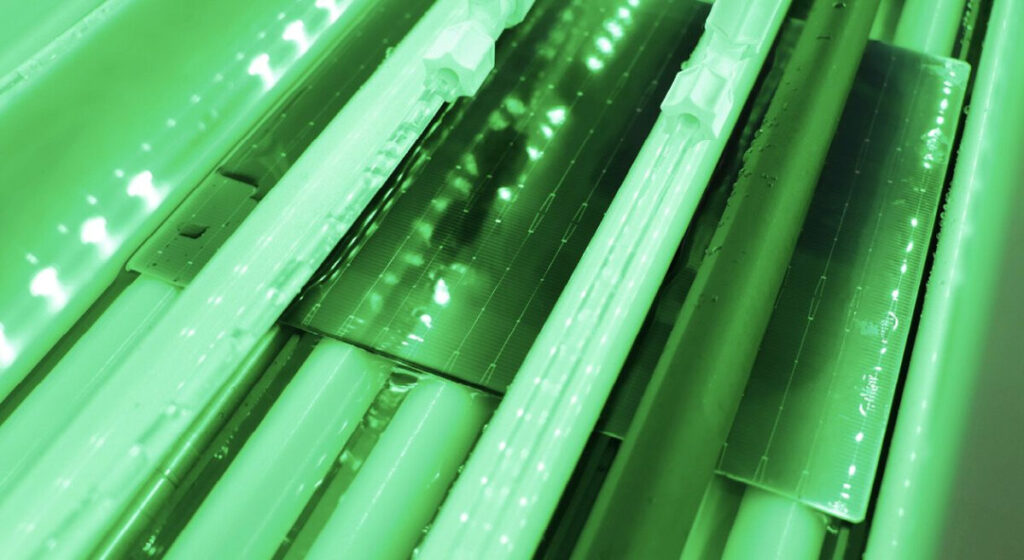The solar industry has ignored the issue of silver dependence for cell metallization, but China’s Jiangsu Xianghuan Technology (JXTC) is moving to commercial production with a copper plating process that overcomes many of the challenges that cell manufacturers have shown little interest in.
The recent growth in solar energy production has raised concerns about the availability of certain materials at the scale needed to bring solar installations close to global 2030 targets. Most important of the materials in question is silver. A 2021 study from the University of New South Wales estimated that current silver consumption would limit the global solar industry to 227 GW of tunnel oxide passivated contact cell (TOPCon) production, less than half of the up to 568 GW of global ask for PV that InfoLink indicates. Consulting has a forecast for 2025.
It has long been known that solar energy would ultimately encounter limitations in the supply of silver. Since silver is also one of the most expensive materials in cell production, there are plenty of incentives to find an alternative. Many have been proposed, but the proven and optimized process of silver paste screen printing has proven difficult to replace.
When formed into a paste for screen printing, other materials lack the conductivity of silver. Plating processes allow the use of pure copper, potentially achieving even better conductivity than silver paste. That approach has proven difficult to implement in production without causing damage to vulnerable silicon cells, but market conditions in 2024 have highlighted the need for an alternative to silver. JXTC is introducing a copper plating process that it says avoids the risk of damage to cells during processing. The company also claims to be able to demonstrate the speed and uniformity required for large-scale production.
One of Xianghuan’s founders previously worked at cell and module manufacturer Suntech, which started exploring copper plates back in the early 2000s. Together with others, he continued to develop the technology and came up with the “horizontal double-sided copper metallization process” (HD Plate), which the company now plans to introduce to solar manufacturers.
The process is described in an article published in the journal Progress in photovoltaics. JXTC says it has already established a 300 MW pilot line and recently announced it will supply resources to an unnamed manufacturer for a 1 GW production project. Lu Wang, who presented JXTC’s technology at the European Photovoltaic Solar Energy Conference and Exhibition (EU PVSEC) in September 2024, explained that using rollers instead of clamping the cells in place during processing results in a much lower cell breakage rate. “Silicon wafers are fragile, especially as they become increasingly larger and thinner,” says Wang. “With our process we don’t have to worry about wafer breakage and we can plate any type of cell, including TOPCon, heterojunction, back contact and others.”
Australian company BT Imaging has also developed a method to monitor the electroplating process and ensure the quality and reliability of copper-plated cells.
Test results
During tests, the company manufactured TOPCon solar cells measuring 182 mm. Since plating cannot be performed on the top silicon nitride layer, the cells were first treated with an ultrashort pulse laser to open the layer along the areas to be plated. Both sides of the cell were then plated simultaneously with nickel and then with copper, the process providing the ability to control the plating conditions of the front and rear cell surfaces separately.
These cells achieved an average light conversion efficiency of 26.26%. The copper-plated fingers also met industry standards for mechanical strength, meeting the minimum requirement of 0.8 Newton (N) and registering an average strength of 2.5 N, slightly above the average of 2.47 N for control cells using screen printing were made.
Wang also said that since electroplating allows for thinner fingers than can be achieved with screen printing, further optimizations should be able to achieve even better performance, with the thinner fingers having lower series resistance and leaving a more active cell surface exposed to sunlight .
Go to the market
Wang estimated the current cost of cell metallization using silver for Chinese manufacturers at CNY0.08 ($0.01)/W, and said that with HD Plate the company should be able to reduce that to CNY0.03/W. “And this is from the very beginning, with the scale of mass production I think we can go even lower,” he said.
For now, JXTC is focusing on its 1 GW project, which Wang said will be built in late 2024 and fully ramped up in March 2025. He also said the company is in close communication with tier 1 cell manufacturers in China and is confident that demand will begin to emerge as the process proves itself at scale.
Wang is also keen to look beyond China to other markets to establish PV production globally. He notes that copper production carries an inherently lower carbon footprint than silver, another potential benefit for producers in regions such as Europe that impose restrictions on industry emissions. Wang also pointed out that HD Plate, as a new process, could help cell manufacturers avoid intellectual property issues in the production of TOPCon cells.
This content is copyrighted and may not be reused. If you would like to collaborate with us and reuse some of our content, please contact: editors@pv-magazine.com.

